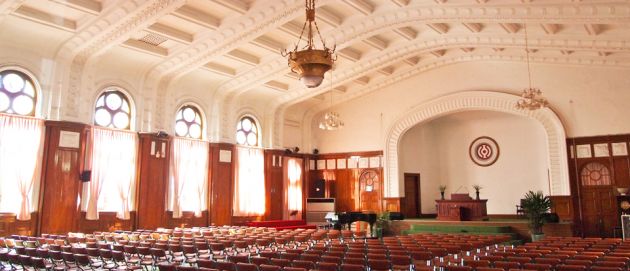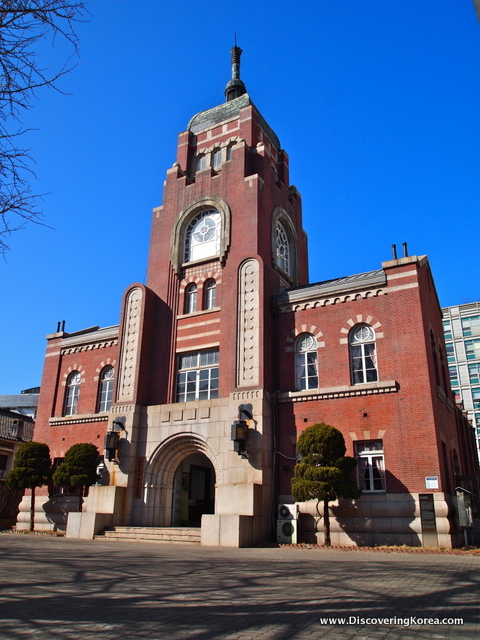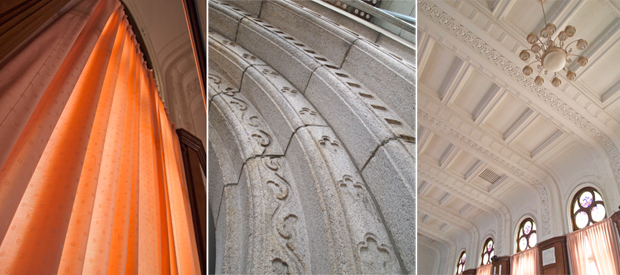The Buddhist and Christian religious faithful form two of Korea’s largest spiritual communities, and both came by way of China. Buddhism entered Korea in the 4th century and Christianity in the early 1600s.

But before Koreans accepted these foreign imports, Korean shamanism was the dominant religion on the peninsula. However, even into the modern era, Korea has developed its unique religious traditions.
One of the most significant Korean religions of the 20th century is Cheondoism. Located on the edge of the popular Insa-dong neighborhood is the Cheondogyo Central Temple Seoul (천도교 중앙대교당).

Built of beautiful red brick and granite between 1918 and 1921, its curious mix of styles form what was once among Seoul’s three most beautiful buildings, along with Myeongdong Cathedral (명동대성당) and the former Resident-General Building.
The majestic Cheondogyo Central Temple Seoul was built in an Art Nouveau style with a baroque roof and a multi-layered front portal reminiscent of a Gothic cathedral.
This architectural fusion is fitting, since Cheondism is itself a fusion faith combining elements of Korean shamanism, Buddhism, Taoism and Christianity. The religion has its roots in the Donghak Peasant Rebellion of 1894, and its core tenant is to create a paradise on Earth by living an intelligent, moral life.
Today, only a small number – about 50,000 people or one percent – of Koreans practice Cheondoism, or the “religion of the Heavenly Way.”
But the faithful numbered many more in the early part of the 20th century, when some two million Koreans were counted as practicing Cheondoists in 1926. That number was ten times the size of Korean Buddhists at the time.

As an indigenous religion, perhaps it’s fitting that the Cheondoists played a leading role in Korea’s independence movement against Japan.
When activists read the nation’s Declaration of Independence at Tapgol Park on March 1st, 1919, among its 33 signatories were a multi-faith contingent that included Cheondoists.
Members of the faith even delayed their central temple’s construction because building funds were diverted to support Korea’s independence struggle.
Curiously, despite its significance as a symbol and sanctuary for Korean nationalists, the Cheondogyo Central Temple Seoul was designed by a Seoul-based Japanese architect, Nakamura Yoshihei and built by Chinese laborers.
Furthermore, it’s said that the temple’s design was strongly influenced by German architecture, thanks to Nakamura’s assistant, the Austrian Anton Feller.
No matter their origin, what they constructed remains one of Seoul’s most attractive buildings. The T-shaped church is dominated by a large main area that features rows of chairs set underneath a gently sloping white ceiling lined with images of the mugunghwa, or Rose of Sharon.
As the national flower of Korea, the flower had special significance to the nationalists.
After being covered in scaffolding for several months as it underwent restoration, the four-story Cheondogyo Central Temple Seoul has been reborn as Tangible Cultural Property No. 36.
And today, the Cheondoists’ regal headquarters continues its role of providing a venue for religious services, political events and a wide range of public activities.
After some 90 years, the Cheondogyo Central Temple Seoul continues to promote the active engagement of Koreans in public life.
For Your Information…
| Open: | Normal business hours |
| Admission Price: | Free |
| Address: | Seoul Jongno-gu Gwanhun-dong 30-1 |
| Directions: | Seoul Metro’s Anguk Station (#328) on Line 3, Exit 5 |
| Phone: | 02-735-7579 |
| Website: | Official Site |
About Matt Kelley
Matt Kelly is native of the US Pacific Northwest and is half-Korean by ethnicity. He lived in Korea for five years and has written hundreds of travel guides for Wallpaper, TimeOut, the Boston Globe and Seoul Magazine and was a host for several different variety shows on Korean radio and television.
